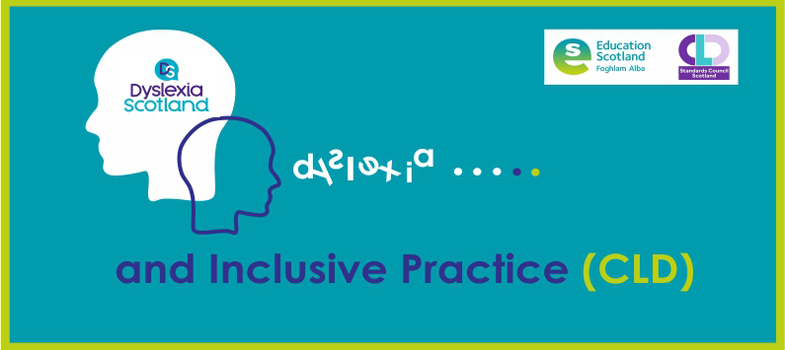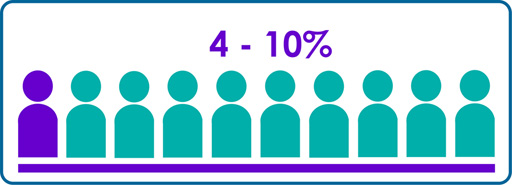1.4 The Impact of Dyslexia
Dyslexia can have positive and negative impacts on children, young people, adults, parents/carers and educational professionals.
In children, young people and adults, when dyslexia is unidentified or unsupported the negative impact can be high.
Many adults participating in CLD activities will never have had a formal assessment for dyslexia. Their dyslexia may not have been picked up in school and their school experience is likely to have been poor because of this. They may have been labelled (or self labelled) as ‘stupid’ ‘slow’ or ‘lazy’ Others may have been identified but carry with the dyslexia label a stigma of poor literacy skills with low achievement expectations and poor self-confidence.
Conversely, there will be many adults who say their poor literacy skills are due to dyslexia as it may be easier to say they are dyslexic than to say they cannot spell or read very well. Often they will say that a teacher or other adult told them they were dyslexic but were never actually assessed and may not be dyslexic at all. Or they may have labelled themselves dyslexic, feeling that this is more acceptable than the alternative labels people might give them.
Activity 3
Think about your own experience of working with learners with dyslexia.
This is the list of factors associated with dyslexia that we identified as having an impact on individuals.
| Creativity | Spatial awareness | Frustration |
| De-motivation | Social skills | Resilience |
| Relationship difficulties | Lower achievement and attainment | Isolation |
| Low self-esteem | Ridicule | Mental health |
| Attention to detail | Problem solving | Depression |
| Fewer qualifications | Determination | Stress |
| Anger | Feeling different |
In your reflective log note down some of the factors that have a positive impact and some which are negative.
Click 'Discussion' to see what we thought.
Discussion
Do note that these factors are contextual and there is no right or wrong answer.
| Positive impact | Negative impact | Positive and negative impact |
|---|---|---|
| Creativity | Frustration | Social skills |
| Spatial awareness | Anger | Feeling different |
| Verbal skills | Isolation | Perfectionism |
| Holistic thinking | Low self-esteem | |
| Attention to detail | Ridiculed | |
| Problem solving | Mental health issues | |
| Practical tasks | Depression | |
| Determination | Fewer qualifications | |
| Resilience | Stress | |
| Feeling different | ||
| De-motivation | ||
| Relationship difficulties | ||
| Anxiety | ||
| Perfectionist | ||
| Lower achievement and attainment outcomes |
Dyslexia is often misunderstood and over the years a number of misconceptions have circulated.
Activity 4
a.
Dyslexia is all about reading and spelling difficulties
b.
The incidence of dyslexia is higher amongst males
c.
Not many people are dyslexic
d.
Only ‘clever’ people have dyslexia
e.
Dyslexia is a sign of low intelligence
f.
Dyslexia cannot be a disability
g.
In Scotland specialist staff are required to provide appropriate support, planning and monitoring of dyslexic children, young people and adults
No correct answers.
Discussion
1.Myth - Dyslexia is all about reading and spelling difficulties
Fact
Dyslexia does not only impact on literacy – reading, writing and spelling.
The working definition highlights the other characteristics shown below which can also impact on:
- auditory processing of language-based information
- oral language skills
- short-term and working memory
- sequencing and directionality
- number skills
- organisational ability
2. Myth - The incidence of dyslexia is higher amongst males?
Fact
Previously this was a widely-held belief that dyslexia affects males more than females. This is most likely due to the differences in coping strategies employed by each gender. Current consensus supports the belief that males and females are equally affected; although this remains an area of debate.
3. Myth –Not many people are dyslexic
Fact
There is consensus that between 4 – 10% of the population are dyslexic - although not all will have a formal identification of dyslexia and this remains an area of debate. It is estimated that one person in ten is dyslexic in Scotland (approx. 550,000), with 1 in 4 of those 10 (2.5%) classed as severely dyslexic.
4.Myth - Only ‘clever’ people have dyslexia.
Fact
Dyslexia does not only occur in ‘clever’ people. Historically it was believed dyslexia was only identifiable when the learner had a ‘jagged profile’ or a noticeable gap between what the learner knew and could speak about compared to what they could demonstrate by reading and writing. However, consensus now holds that dyslexia exists across all ability levels. The current Scottish definition of dyslexia recognises many aspects indicative of dyslexia aside from simply language processing.
5. Myth - Dyslexia is a sign of low intelligence
Fact
As with myth 4, dyslexia is not a sign of low intelligence and does not only occur in ‘clever’ people. Historically it was believed that dyslexia was only identifiable when the learner had a ‘jagged profile’ or a noticeable gap between what the learner knew and could speak about compared to what they could demonstrate by reading and writing. However, consensus now holds that dyslexia exists across all ability levels. The current Scottish definition of dyslexia recognises many aspects indicative of dyslexia aside from simply language processing
6. Myth - Dyslexia cannot be a disability
Fact
The Equality Act 2010 recognises Dyslexia as a protected characteristic when the impact on the individual is significant/severe.
7. Myth – In Scotland specialist staff are required to provide appropriate support, planning and monitoring of dyslexic children, young people and adults support, planning and monitoring of dyslexic learners.
Fact
All practitioners have the skills and abilities to recognise early signs of dyslexia in children at all stages, and take appropriate action in response, although they may benefit from some support to develop these skills. However this does not mean that all CLD practitioners are responsible for the formal identification of dyslexia. It means they play an important role in the initial stages and ideally with the continuing monitoring and assessment of learning.
Recognising early signs of difficulties and adapting learning and teaching approaches are a regular part of the daily routine for practitioners supporting individuals in an education environment.
Further information to support literacy difficulties and dyslexia can be accessed on the Addressing Dyslexia Toolkit [Tip: hold Ctrl and click a link to open it in a new tab. (Hide tip)] and Dyslexia Scotland’s website.
If your answers were not all correct you may wish to refer back to the Scottish definition of dyslexia at the start of Section 1. .
1.3 Background to Dyslexia

